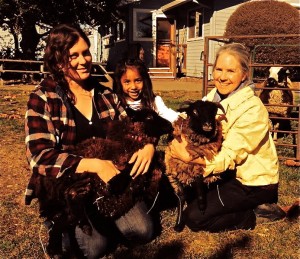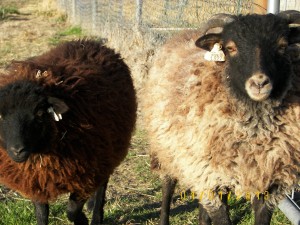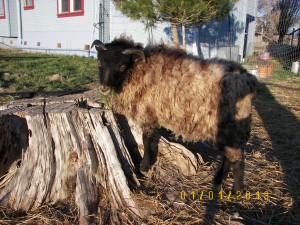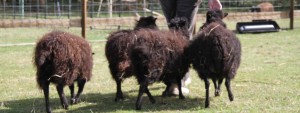
Small, cuddly sheep photo by Mary Olsen
Fiber and sheep enthusiasts take note! This fall the first representatives of the Ouessant, an intriguing breed of sheep new to North America, made the journey in the back seat of a Prius from the Massachusetts Coast to Heart Felt Fiber Farm in Sonoma County. They were born at Breton Meadow Farm in Lincoln, Massachusetts, which is undertaking an “upbreeding” program using artificial insemination to establish the useful little Ouessant sheep in North America. This pair of backseat travelers will add to the already diverse array of handspinning fibers produced by the small spinning herd at Heart Felt Fiber Farm (comprising Icelandic and Shetland sheep, fiber goats, llama and alpaca).
Just before Thanksgiving ten more little sheep arrived by truck, most of which will take part in the Capella Grazing Project, a novel pilot vineyard grazing project, described in the following article.
The Ouessant sheep breed is the smallest breed of sheep in the world (topping out at less than 20 inches at shoulder and 35 to 50 pounds) and is also has the largest wool yield of all breeds, producing 10% of body weight in lustrous wool. These hardy, primitive little sheep are attractive, lively, intelligent and friendly, and can adapt well to small land holdings that would be unsuitable for large sheep. Extirpated from their native island of Ouessant (off the coast of Brittany, France) by the 1950’s, the breed was subsequently rescued by dedicated sheep fanciers in France. Now there are flocks in Great Britain and various European countries (www.ouessantsheep.net, www.ouessants.blogspot.com).

ouessant come in many colors

and they are good for small properties

they are easily managed
The favored black wool of the Ouessant was traditionally handspun and handwoven to make the standard black clothes worn by married women on the island up to at least the beginning of the 20th century. (Black still predominates in the breed, but caramels, greys, browns and whites also occur.). As members of the family of Northern European short-tailed sheep (e.g. Icelandic and Shetland sheep), the Ouessant is a long-wool dual coated breed with a thick fleece comprising a very dense fine inner coat and longer outer coat. The average fiber diameter is 27-28 microns, but in primitive sheep this average of all fibers doesn’t tell the whole story of the soft hand resulting from the tendency of the very fine fibers to coat the core of stronger fibers when handspun. Detailed information and about Ouessant wool characteristics and end uses can be found at www.spinningshepherd.blogspot.com, which reports as a spinner that the “relatively fine wool mixed with lustrous supple fibers look and feel oddly like mohair”.
The wool is suitable for fine knitting and soft weaving yarns and it felts beautifully. These tiny sheep produce up to 4 pounds of wool annually, comparable to larger breeds. The breed has many fans across the Atlantic, where they are used extensively for eco-grazing (e.g. city parks in Paris, back yards, estates, etc. They are also becoming very popular among aging shepherds because they are so easy to manage and handle.
Establishing a new sheep breed on this continent is no small feat, as no imports of live sheep have been allowed for years due to concerns about introducing new sheep diseases to the U.S. Recently, even the importation of sheep semen has been banned, pending development of new protocols. Karen Seo and Ray Tomlinson of Lincoln, Massachusetts started the Ouessant upbreeding program in 2009 (before the import of semen was banned) by importing semen from four English purebred Ouessant rams. Through artificial insemination starting with 40 domestic Shetland ewes, they have managed to produce crossbred lambs in successive years that have increasing Ouessant blood. By November of 2013 fall they had produced 19 high grade ewes of ¾ to 7/8 Ouessant (balance Shetland), which were again artificially inseminated for another round of lambs to be born spring 2014.
For more details on the Breton Meadow Farm upbreeding program, go to www.bretonmeadowfarm.com, but be aware that Karen and Ray are so busy between their day jobs and shepherding that they don’t always find time to keep their website updated. For future breeding seasons, Breton Meadow Farm needs to import semen from new rams to achieve pure Ouessants without inbreeding, and this depends on the ban on the import of sheep semen being lifted in the near future. Most of the twelve little sheep that arrived in California last fall are 63% Ouessant/27% Shetland, thus still slightly larger than the breed standard.
We think that the Ouessant breed will fill a unique niche in the fiber arts, sustainable eco farming, and micro farming communities. Unfortunately, it will probably be at least two years before any more Ouessants will be available to add to the population here in California. Breton Meadow Farm is retaining all of the highest percentage Ouessant ewes for their upbreeding program. And currently there are no suitable rams for the twelve little ewes already in Sonoma County, because the rams created by artificial insemination thus far are too closely related. The bottom line is the ban on importation of sheep semen must be lifted before Ouessants can be established in California. In the meantime, if you’re longing to see these charming little sheep in person and check out their fiber, you can make an appointment to visit Heart Felt Fiber Farm or you can become a sponsor of the Capella Grazing Project.

small lawnmowers!
Leslie and her husband Alden moved to West Sonoma County last year with their diverse spinning herd after selling their eco-friendly inn/mini farm in West Marin. Leslie manages Heart Felt Fiber Farm as a no-kill mini eco farm, applying some of her professional background in environmental science to sustainable farming combined with more recent interested in spinning, weaving and felting. You can reach her at info@heartfeltfiberfarm.com. For more information go to http://www.heartfeltfiberfarm.